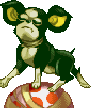-
Content count
129 -
Joined
-
Last visited
-

What are the most coherent original Doom level names?
Caffeine replied to Astro X's topic in Doom General Discussion
Entryway is, in fact, the way one enters Doom 2. Spot on. -

How the hell do the stair builder line actions work???
Caffeine replied to CNDLWYX's question in Editing Questions
Worth adding that Stabbey's explanation is for vanilla Doom: if you are using Boom or UDMF there are other methods. Boom has generalized stairs that allow you to control them more precisely. For example: generalizing up or down, 8 or 16 units, speed, whether or not the stairs reset to their initial state, and whether individual steps need to have the same floor flat. https://zdoom.org/wiki/Generic_Stairs. Other than that, they follow the same building behavior as the OG Doom type. UDMF supports Boom's method, but also has action special 27 (among others) that offer even greater control. Sectors in UDMF can have several effect types, including 26 and 27 which are required for the UDMF stairs action specials. The sector tag indicates which is the first step: from there, the engine looks for adjacent sectors that have alternating effect types of 26 and 27 but still going from "line front" to "line back" to find them. This way, sectors can have wildly different properties although I believe the floor height must still be the same. Anyway, this is nice because you can have a ton of sectors that might otherwise be triggered by the stair builder, but due to the constraint of those new effect types, stay put. In other words, it is more difficult to screw up although it does take more work to set up. -

Recommendation of ANIMDEFS language code that works with the animated water texture.
Caffeine replied to Johnny_Vicc_007's question in Editing Questions
It is literally the same program but with seven years of bug fixes and improvements. I have read several threads in this forum where an OP had problems doing something, and using up-to-date UDB3 instead of GZDB stagnant for seven years fixed their problems. But you do you. -
Okuplok isn't even all that great looking. Not bad or ugly, but certainly not "beautiful." It is big, and fills those big areas with ludicrous quantities of monsters. However, its arenas look rather plain and boring. Wads like Sunder at least have gorgeous architecture. If you do not like slaughter maps, then I recommend not playing slaughter maps. It is not like they are difficult to avoid. There are plenty of maps that look really nice and have less spicy monster counts.
-

Recommendation of ANIMDEFS language code that works with the animated water texture.
Caffeine replied to Johnny_Vicc_007's question in Editing Questions
Unrelated to your question, but I strongly recommend using UDB3 instead of GZDoom Builder. The latter was discontinued in 2017. Source. UDB3 is a fork of GZDB that is actively maintained and it includes numerous bug fixes and support for newer engine features such as MBF21. -

when a group of monsters are killed
Caffeine replied to DOOM's supershotgun's question in Editing Questions
I think it works fine for an arena or boss fight. However, you are correct: that is mostly against the feel of classic Doom. I think the item pickup variant of this, requiring UDMF's ability to trigger action specials from Things, is perfectly acceptable. It works more reliably than enclosing something like a key or powerup in a square of linedef triggers. It sounds like you are probably a beginner: I strongly recommend watching some Doomtuber videos about editing and referring to the ZDoom wiki as needed. Here are some resources to get you started: Chubzdoomer Bridgeburner ZDoom Wiki -

when a group of monsters are killed
Caffeine replied to DOOM's supershotgun's question in Editing Questions
As far as I know, the only way to do this requires ACS scripting in a ZDoom-family source port using UDMF. script "DoSomething" OPEN { while (ThingCount(T_NONE, 53) > 0) { Delay(35); } Door_Open(54, 32, 0); } The script runs when the level loads. It loops while there are any active Things with tag 53, constantly sleeping for one second each time which prevents the script from being killed by the engine for taking too much compute time. Once the monsters are killed and no longer active, the loop breaks and the remainder of the script executes. In this case it opens doors with sector ID 54, but you could perform a different action or even multiple actions if you want. While not part of your question, this also works for item pickups. For example: I have used effects such as a blue light centered on a soul sphere and the light turns off when the player picks up the armor. This creates a "glowing powerup" effect tied to the existence of the powerup. The ThingCount function can also work by specifying an item type as the first argument, and a zero Thing tag. This way you can do something similar to MAP07's lowering floors when all Mancubuses are dead, or raising a step when all Arachnotrons die. This technique is also compatible with Doom-in-Hexen format since it does not use Thing tags which are only supported by UDMF. -
Length of gameplay is more important than physical level size. Ultimately, this call is subjective: however, I would personally expect at least several minutes of play from a level. Even in wads that have an introductory "no monsters" MAP01 it generally takes a minute or two to wander around and take in the sights before moving on to the "real" first level. Regardless, please do not let this discourage you if you are new to mapping, which it sounds like you are. Even if this level is small, finish it up with monsters, weapons, and ammunition. Play it a few times, and start expanding. Maybe one room feels like it could use an optional area to the side: add it. Mapping is an iterative process and you will not be finished in a day.
-
Out of memory error simply means the program asked the OS for more memory, but the OS said "no." The program can only assume this is because none is available: however, there are other possibilities such as hitting a maximum heap size while there is still plenty of unused system memory. If the entire system was low on memory then you would very likely have other problems, mostly to do with system stability and responsiveness. As others mentioned, you are best off mentioning this to the program's author who should be able to dig into it more and provide better guidance. Does this happen frequently or is it a one-off occurrence?
-

Honest opinions on Shores of Hell and Inferno?
Caffeine replied to Orchid87's topic in Doom General Discussion
E1 will always have a special place in my heart, same as with many other people. I played the hell out of the shareware episode way back in the day and it was heads and shoulders above any game that came before it, even in the 320x240 resolution of the day. It also has really good balance overall - not perfect, but good. Nostalgia is strong here, but I do replay the entirety of E1-E4 every year or two and E1 is still strong in my opinion. E2 and E3 do not measure up to the game play and balance of E1. They are not horrible, but very... meh. Visually, they are mostly a step down, although I try not to judge the OG maps in either game too harshly given the primitive nature of id's map editor and the hardware of the day. Still, I think some more textures and slightly more detail in some areas would help: essentially, the levels needed a little more time in the oven before release. Balance can be a bit all over the place, with it mostly being too easy but also boring at times. Baron is the only "tough" monster, but generally the player does not have the right weapons and ammo to take them out efficiently. In general, Doom 1 will always be weaker than its sequel due to the lack of the SSG and many mid-tier enemies. Its bestiary is heavy on hit-scanners and the Baron is a bullet sponge, leaving very few interesting monster choices. This is not specific to E2 or E3: this is my opinion of Doom 1's selection of weapons, monsters, and textures. E2 and E3 have to live with those limitations. This means, in my opinion, that they start from a position of weakness when compared to anything built on Doom 2. E1 can get away with this because other than E1M8, it has no tough monsters: it is full of fodder which matches weapon availability and it has a strong, cohesive theme. -
Stabbey is correct but I would like to add a little detail, specifically with regards to generalized doors (UDMF, Boom) as opposed to OG Doom's DR/SR/WR/GR doors. Sector tags are only needed when the door is not on the backside of the activating linedef. This is how you can open a door from a switch, shootable switch, or walking across a line and the door is not physically behind the line. It is normal not to use sector tags when the activating linedef is a boundary of the door sector itself. As mentioned in a different recent thread, using sector tags with "regular" doors is actually wrong (usually) because the player cannot close the door. The door cannot be interacted with again until it closes.
-
There are two ways to do this, depending on what source ports you want to target. Boom: you create a hallway separate from the map with a scrolling floor. Put a voodoo doll (extra player 1 start) at one end, and several obstructions such as doors or high floors in front of the voodoo doll such that the floor moves the doll and it gets stuck. Each switch that triggers whatever it is you want opens one of those doors or lowers a floor, allowing the voodoo doll to move past them eventually. After the obstructions, you put however many linedefs you need where each one triggers an action when the player walks over. This method allows you to have one switch trigger multiple different actions. One switch in the basic game can open multiple doors that share a tag, but this Boom method allows one switch to open a door, raise some stairs, and lower a different floor. You can also have multiple switches required to do one action, such as flipping three switches to open a door. You can combine those in a many-to-many relationship where you need to hit three switches in order to perform multiple actions all at once. There are many, many examples of this method out there. Open up pretty much any non-trivial Boom map and look for hallways that are not reachable from the main area of the map, and see what triggers sectors inside of them and what their linedefs trigger elsewhere. Copy this method in your map if you want to use the Boom approach. GZDoom: if you create a new map using UDMF+GZDoom configuration in UDB3, you can write an ACS script to do whatever complex actions you want. It is a bit more intuitive because you can simply write the ACS action specials in your function one after another, making it nice and easy to read what it does instead of the Boom method that requires looking around the level and paying attention to the activation arrows which can get messy. The disadvantage is this only works in ZDoom-derived ports: basically anything that understands ACS and the "zcommon.acs" import. In both cases, Stabbey meant when you create a new map, UDB3 presents a dialog box that asks what configuration you want to use, like this: The first element in each list item is the source port target such as Boom, DSDADoom, GZDoom, MBF21. Some of those are specific ports (GZDoom), others are categories of ports that support a common feature set (MBF21). The part in parenthesis is the file format and new levels should generally either use Doom or UDMF format depending on what source ports you want to support. Based on what option you select here, UDB3 presents different capabilities when you edit the map especially with regards to action specials.
-
@Laz Rojas I recommend reaching out to the Institute for Justice. They are not a typical law firm: they are a non-profit organization that among other things, litigates cases that involve egregious violations of Constitutional rights. I cannot say for sure that this is the type of case they would litigate, but a public prosecutor using a heavy hand to fabricate charges against someone he clearly did not like should at least get your foot in the door with the IJ. They run off of donations and probably a cut of the court winnings like most lawyers, so it should not cost you anything. It appears they do not have a physical presence anywhere in California, so you will need to reach out online.
-

UDMF/GZDoom :: Diagonal Shadows along a Wall
Caffeine replied to Lutz's question in Editing Questions
Since you are using GZDoom and UDMF, the easiest way is to use point lights: Thing types 9800 or 9840. The documentation on this is a bit thin, and I find it better to search the ZDoom forums rather than the ZDoom wiki. Here is one topic discussing how to set them up: https://forum.zdoom.org/viewtopic.php?t=68084 If you use regular lights, Thing type 9800, then it is fairly simple. Create the thing, and be sure to position it vertically where it casts the shadow at the angle you want. Then set its intensity, where the value is pretty much the range, in map units, that the light reaches. The light shines in all directions. In the example you posted, you may need multiple identical lights across that edge to get a similar effect. You can also use a spotlight, Thing type 9840, if you instead want it to imitate a real-life recessed light where it shines in a cone. In that case you need to mess with its roll, pitch, and angle which aim it in three dimensions. Sorry, but I never remember exactly how those work and I always have to test them in visual mode or in-game to figure it out. Intensity works the same, and there are two angles: inner and outer. These are sort of like the umbra and penumbra in astronomy, except with light instead of shadow. The light shines full bright in the inner angle, and fades out to nothing between the inner and outer angles. There are also varieties where the lights flicker on/off at a specified interval, or pulse between off and on. Again, I always have to test those out to get the effect I want. Regardless of how you set up light Things, I recommend augmenting the effect with sector lighting. With UDMF you can set independent floor and ceiling lights to make the effect more realistic. One of these days I should probably create an account and document this on the ZDoom wiki. -

Conceptual differences between ZScript and ACS?
Caffeine replied to aRottenKomquat's question in Editing Questions
I am not sure that ZScript can call ACS. Generally it is the other way around. ACS is designed for manipulating a level, while ZScript is closer to the engine itself. As far as I am aware, ACS is loaded per-level, although you can have common scripts included by all levels. ZScript is always there, hanging out in the background, even when a level is not loaded (e.g. at the initial menu). ZScript documentation is a perpetual work in progress, which makes sense given the project is run by unpaid volunteers as a side gig. They do the best they can and I appreciate their hard work, but ultimately, GZDoom is not a project that pays its developers full-time to work on documentation or other dev tasks. I am a software engineer as well, and I have had to figure a lot out on my own through the ZDoom forums and reading the GZDoom source code myself. I do want to point out that the project source code is more than the C++ engine code: it also contains the base resources including built-in ZScript and even wad resources such as MAPINFO and LANGUAGE lumps that it uses for the base games. Since you are also a software engineer, I strongly recommend looking through the built-in ZScript in the GZDoom source repository. That is a great way to understand how it works, view the base ZScript classes, and generally wrap your brain around scripting.





